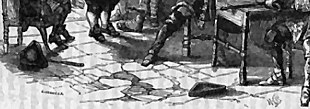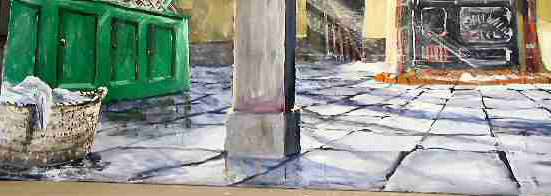What do you recommend for the painted floor of a platform representing,
amongst other scenes, the interior of a tavern in the middle 1800s, in
England?
Painting Flagstones. (Stone slabs which we call "flags”
here)
This is how I would go about painting them,
But before we start, old clothes and old shoes are essential because you
are bound to get wet paint on them and on the soles of your shoes.
The following “instructions” are based upon the premise that
you can have the platform for a complete day, free from anyone walking
on it or erecting scenery.
Mark out the floor (I’ll call it the “floor” from now on.) with flagstones Very very roughly two feet by two feet but don’t make them all the same size. Use chalk or charcoal to do this marking.
 |
Remember when these flags were laid, the builders used whatever size was available, so we must be random. On the left is a detail from a drawing of a tavern floor in 1775 |
Now have a container of white paint and one of light grey. Use the light grey first and, using a big brush, say five inches wide, paint one flagstone. Make the corners round. Next, whilst it is still wet, paint on some white which will blend in with the grey. Paint the white only in places on the flag. Not all over.
Move next over to another flag, well away from the first, and paint it in a similar manner. By hopping about to different parts of the floor you help to randomise the colours. (As your work progresses you will pick up grey on your white brush so the flags will be different colours.)
When all the slabs are painted, and even if they are still wet, using your large brush, flick dark grey spots over them all. Then spots of white paint also. Don’t try to flick one slab at a time. Do the lot in one go. Of course you can only do this flicking task if there are no curtains or pieces of scenery in the area, as the paint will over-spray off your floor. This gives the flags a texture which may not be visible from the back row of the audience but nevertheless has an affect on the general worn look of the stones.
Can’t flick the paint? Then break a large bath sponge in half to reveal an irregular face then dip this face (so the face of the sponge just touches the surface) in your two containers of paint and dab the paint on that way. Don’t worry about the splatters and splodges going into the “cracks” between the flags. Incidentally, I regularly do this sponge business using two or three colours at the same time on the same sponge face, especially useful when painting foliage.
Next decide which way the light is apparently coming from in your scene. The direction s not really important as long as each flag is lit from the same direction.
 |
The above photo is of a floor I painted for the Kitchen scene in "Me and My Girl" . Of course the flags are painted in perspective but the principal of light edges and dark edges still applies.
Using pure white, colour just the two edges of each flag that are nearest the light “source”. Now do the opposite and use a dark grey to edge each flag the far side from the light source.
At this stage you could even scrub a little light green into some of the cracks and on to a few of the flags. Even a little blue in the centre of one or two flags to hint at water. (The audience will not notice and their subconscious will register there is a hole in the tavern’s roof!)
Let the whole floor dry. Now paint with a dark grey all the gaps between the flags (This will obliterate your splodges which fell on these cracks.)
Finally use a very small brush and paint in black a few thin “cracks” across some of the flags. Don’t overdo it.
Let it dry and review the whole floor. Too strong and dominant? If so, scrub some white over the whole floor - wiping off with an old rag as you go,- to leave just a mist of white over the whole painting. You can also use crumpled up newspapers to wipe the paint off too. I sometimes use a paint roller of white which I run up and down a scrap piece of board first to remove most of the colour, and then roll it over the flags. If the white is too translucent then wipe with a damp cloth before it dries, leaving just a trace of colour behind.